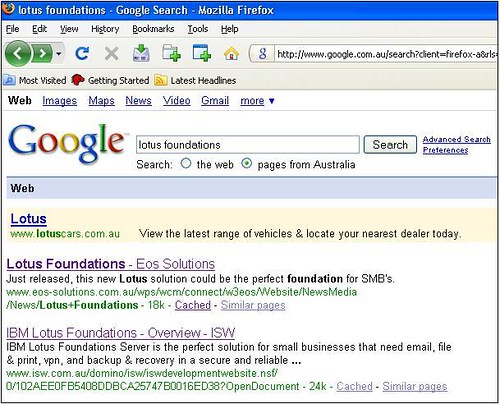Laurent Lachal is a Research Director for Ovum and currently in charge of Ovum's open source research practice. He has
posed the intriguing idea that IBM should not have branded Lotus Foundation Server as a
Lotus product.
His theory is that the SMB market and the mid-market require different product branding from the product lines in vogue at the the Big End of Town and that since IBM already branded Lotus Domino as
"...the enterprise collaboration software platform of choice for the majority of the Fortune 500 companies..." it needs a different branding strategy to succeed in the SMB market. When talking about Lotus Domino, Laurent says:
"The lower end of the SMB market is a completely different beast to the Fortune 500 market, and trying to embrace them both with the same offering is a big, if rather common, mistake."I think he's wrong. I would certainly agree that Foundations doesn't belong under (say) the Websphere, Rational, DB2 or Tivoli brands but I see it as a perfect product for Lotus.
Laurent's first problem is that he hasn't differentiated between Lotus (the company) and Domino (the software). By his logic Microsoft should now spawn two new sister companies -
MajorSoft and
MidRangeSoft if it wants to be successful.
Laurent's next problem is that he is ignoring market history. The Microsoft
Windows operating system and the
Office productivity suite did quite well across all segments of the market without the need to change the brand. Sure they repackaged the product depending on the user with
Windows XP Home etc, but the
Windows brand stayed the same.
The third problem and final nail in the coffin for Laurent's theory is the well-known
Outlook Effect which shows that people who are accustomed to one system interface automatically want to work with it in their next role. Doesn't matter whether they are a successful SMB owner tapped to lead a major conglomerate or a burned-out corporate executive wanting to start his own cornerstore hardware shop, if they've used Brand 'X' software before then they'll want to use Brand 'X' again.
Lotus
is the IBM brand for office productivity software whether the client is a Fortune 500 or a sole trader. The branding of
Lotus Domino and
Lotus Symphony running on networks powered by
Lotus Foundations Servers works well to capture both ends of the market as well as the bits in the middle. Since the Ovum
web site lists IBM as a customer I presume Laurent has already had the chance to pass his ideas on to the Powers-That-Be at IBM.
Thanks for your blog post Laurent, but I won't be taking up a subscription to any of your Ovum Weekly Newsletters anytime in the near future.
BTW Ed Brill is running a post which touches on the question of whether people most identify with IBM or with Lotus as a brand. From my reading of the replies it seems most Domino/Notes users want to stay with the Lotus brand and that's fine by me.
.




